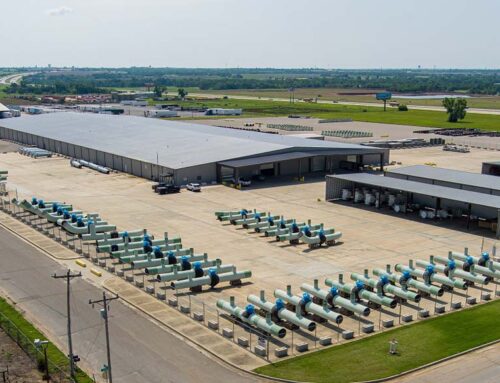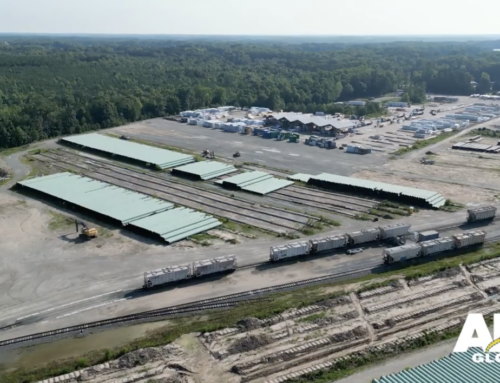Make. Use. Dispose. Repeat. The four steps of the linear economy are well-known and familiar to most. As sustainability becomes more important to all industries, this linear model is being challenged and replaced with a more efficient, waste-reducing model: the circular economy. Most people are familiar with the 4R imperative of the circular economic model: reduce, reuse, recycle, and recover.

Within the energy industry, the energy transition is demanding more sustainable models, including finding ways to integrate the circular economy in currently standing procedures and processes. However, the energy industry has its own unique challenges to consider. Consumption and production have different meanings in an industry that supports and feeds all other industries. Therefore, we’re introducing an augmentation to the circular economy model that better fits the industry that must serve as a resource to everyone else. We’re proposing a 5th R: Re-Sourcing.
In this article, we’ll explain how Re-Sourcing uses peer-to-peer networks to retain value and offer an alternative to energy asset managers to improve sustainability and optimize value while using tested, documented, high-quality project materials.
Why We Need to Improve Models to Benefit the Energy Industry
Several oil and gas companies have already faced pressure to improve ESG ratings and sustainability practices from external investors. And for good reason, too. According to a report published by NYU’s Stern Center for Sustainable Business, there is “a positive relationship between ESG and financial performance” for a majority (58%) of businesses.
The key question is how the energy industry can improve ESG ratings, especially when pipeline projects are commonly villainized in the public eye. New projects are also facing pressure to incorporate sustainable practices to lower costs and more efficiently support projects. For example, new LNG facilities are looking to use renewable energy to lower energy costs to support the facilities.
The key is to increase profitability while improving sustainability, not sacrificing value for the sake of checking an ESG box. That’s where the circular economy comes in. The circular economy is about using materials in the most efficient way possible.
The key is to increase profitability while improving sustainability, not sacrificing value for the sake of checking an ESG box. That’s where the circular economy comes in. The circular economy is about using materials in the most efficient way possible.
Sustainability & The Circular Economy
The circular economy model recognizes that resources are limited and that the linear economy model results in abundant waste and inefficiencies. However, the current 4R imperative (reduce, reuse, recycle, and recover) isn’t always the perfect fit for the midstream industry. Regulations and standards mean reducing and reusing isn’t always the best option. The nature of the business also means that products can’t always be recycled or recovered. That’s why we’ve adapted the model to fit midstream’s needs.
The 5th R: Re-Sourcing
Without the option for “re-sourcing”, customers looking for a more environmentally conscious process for sourcing steel products for midstream products might purchase steel products made by combining scrap metal and raw materials in a blast furnace—in other words, recycling materials. However, this smelting process is still notorious for belching massive amounts of CO2 even if it does reuse materials. Likewise, if an owner-operator is looking to divest unused steel assets—such as from a canceled pipeline project—it might think the only option is to sell it as scrap metal, again introducing more carbon dioxide to the atmosphere.
Re-Sourcing isn’t recycling. It’s also not reusing. Re-Sourcing is accessing a peer-to-peer network to take advantage of ready, immediately available materials that have never been used. It’s leveraging connections, reducing project costs, and increasing project returns in a sustainable way.

Re-Sourcing also falls within the best practices recommended by the Investment Recovery Association. Sellers of idle assets are able to resell the asset, which returns significantly more value than selling the unused assets for scrap. Again, this sustainable practice is not sacrificing value or profitability. Re-Sourcing doesn’t require a premium expense to work; in most situations, it returns more value and efficiency.
How to Re-Source: Sourcing Sustainably and Safely
It’s well known that the energy industry values safety. Safety and compliance are of the utmost importance, and they can’t be sacrificed for sustainable operations or implementing a circular economic approach. Re-Sourcing protects the quality of the product, so it can be used as originally intended for other projects.
Documentation
Properly Re-Sourced materials don’t sacrifice quality and have the proper documentation to maintain safe operations and regulatory compliance. All materials Re-Sourced through peer-to-peer networks should have traceable, verified, and complete records of MTRs, welding reports, qualification documentation, etc., if the exchange is conducted appropriately.
Protecting the Pipeline During Transport and Storage
The movement of physical materials during the Re-Sourcing exchange may seem hazardous or potentially risky, especially as project and asset managers aim to protect the assets as they exchange hands.
Signs of a well-maintained and safe pipe yard include 1) a well-maintained property, with no signs of neglect (overgrown weeds, disorganization, etc.), 2) intentional protection of the pipes, including moisture-retaining linings and grated yards, and 3) water-avoidant practices, including sloping yards.

Safe warehouses should also be well-maintained, organized, and ideally climate controlled to protect the quality of the assets.
All assets should also be marked with a serial number for identification and tracking, especially as the assets are exchanged.
Proper Re-Sourcing
Lean on experienced, expert Re-Sourcing facilitators. ARS Global has successfully Re-Sourced over 500 miles of pipelines in the Gulf Coast area by protecting the quality and managing the documentation of assets through Re-Source exchanges.
Click here to view our inventory.






